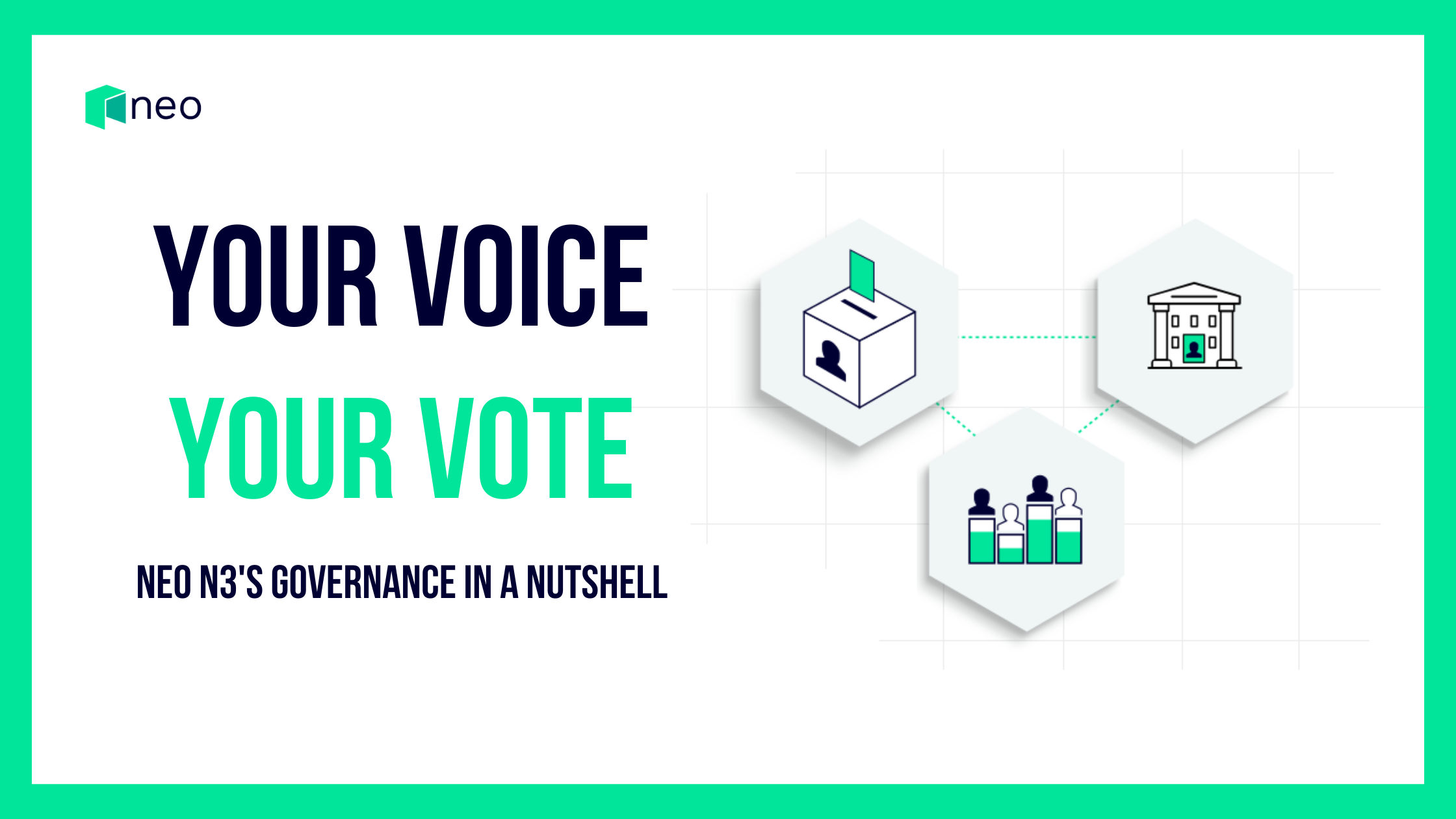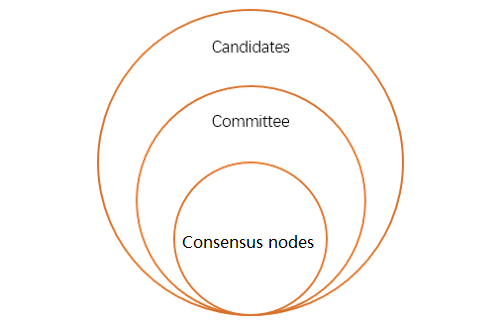Neo N3: Democratizing Blockchain Governance for Everyone
 Ayomide Ayanwola
Ayomide AyanwolaTable of contents
- Introduction
- What's This Blockchain Thing Anyway?
- Enter Neo N3: Blockchain for the People
- Understanding Blockchain Governance
- Neo N3's Governance Model: A Three-Pillar Approach
- Your Vote, Your Voice: Participating in Neo N3 Governance
- NEO and GAS: The Dynamic Duo of Tokens
- Show Me the Money: Incentives in Neo N3
- Why Neo N3's Governance Matters
- Getting Started with Neo N3
- The Future is Neo

Introduction
In the rapidly evolving world of blockchain technology, one platform is making waves by putting the power of governance directly into the hands of its users. Welcome to Neo N3, a next-generation blockchain that's redefining how we think about digital democracy and decentralized decision-making.
But before we dive into the exciting world of Neo N3, let's take a step back and understand some basics for those new to the crypto space.
What's This Blockchain Thing Anyway?
Imagine a digital ledger that records all transactions across a network of computers. Now, imagine that this ledger is transparent, secure, and not controlled by any single entity. That's blockchain in a nutshell. It's the technology that powers cryptocurrencies like Bitcoin, but its potential goes far beyond digital money.

Enter Neo N3: Blockchain for the People
Neo N3 is the latest iteration of the Neo blockchain, often called the "Ethereum of China" due to its smart contract capabilities. But Neo N3 is bringing something special to the table: a governance model that truly puts the community in charge.
Neo N3 revolutionizes blockchain governance by giving NEO holders the power to vote for council members and consensus nodes. These elected officials maintain network vitality and fine-tune crucial blockchain parameters.
To encourage participation, Neo N3 distributes GAS rewards to both voters and elected members, creating a system where everyone has a stake in the network's success.
Understanding Blockchain Governance
To truly appreciate what Neo N3 brings to the table, we need to dive a little deeper into the concept of blockchain governance. Don't worry – we'll break it down into bite-sized pieces!
What is Blockchain Governance?
At its core, blockchain governance is the system of rules, practices, and processes by which a blockchain network makes decisions, implements changes, and manages conflicts. It's like the constitution and political system of a digital nation.
Blockchain governance typically covers aspects such as:
Protocol Updates: How changes to the underlying rules of the blockchain are proposed, approved, and implemented.
Resource Allocation: How the network's resources (like computing power or token distribution) are managed.
Dispute Resolution: How conflicts within the network are addressed and resolved.
Community Management: How the community of users, developers, and stakeholders interact and contribute to the network's development.
On-Chain vs. Off-Chain Governance
Blockchain governance can be broadly categorized into two types:
On-Chain Governance: This refers to decision-making processes that occur directly on the blockchain. Proposals, voting, and implementation of changes are all recorded on the blockchain itself. This is what Neo N3 primarily uses.
Off-Chain Governance: This involves decision-making processes that happen outside the blockchain, often through forums, social media, or in-person meetings. The results of these discussions are then implemented on the blockchain.
Why is Blockchain Governance Important?
Good governance is crucial for several reasons:
Adaptability: Technology evolves rapidly, and blockchain networks need to be able to adapt to new challenges and opportunities. Effective governance allows for timely upgrades and improvements.
Decentralization: One of the core principles of blockchain is decentralization – the idea that no single entity should have control over the network. Good governance ensures that power remains distributed among network participants.
Security: Governance mechanisms can help prevent or respond to security threats, ensuring the network remains robust and trustworthy.
Community Alignment: By involving stakeholders in decision-making, governance helps ensure that the network's development aligns with the community's needs and values.
Conflict Resolution: In any system with multiple participants, conflicts are bound to arise. Governance provides a framework for resolving these conflicts fairly and efficiently.
Challenges in Blockchain Governance
While blockchain governance offers many benefits, it also comes with its own set of challenges:
Voter Apathy: In some blockchain networks, token holders may not actively participate in governance, leading to decisions being made by a small minority.
Plutocracy: In systems where voting power is tied to token ownership, there's a risk that wealthy individuals or entities could have disproportionate influence over the network.
Complexity: Blockchain technology can be complex, and some governance decisions may require specialized knowledge, potentially excluding less technical community members.
Speed vs. Consensus: There's often a trade-off between making quick decisions and ensuring broad consensus, which can slow down necessary changes.
Neo N3's Approach to Governance
This is where Neo N3 shines. Its governance model addresses many of these challenges:
Incentivized Participation: By rewarding voters with GAS tokens, Neo N3 encourages active participation in governance.
Balanced Power Structure: The three-tiered system of candidates, committee members, and consensus nodes helps prevent the concentration of power.
On-Chain Transparency: All governance activities are recorded on the blockchain, ensuring transparency and accountability.
Flexible Adaptation: The committee can adjust network parameters, allowing the system to evolve without requiring hard forks.
By understanding these governance concepts, you can better appreciate how Neo N3 is pushing the boundaries of what's possible in decentralized decision-making. It's not just about creating a new blockchain – it's about reimagining how digital communities can govern themselves in a fair, efficient, and transparent manner.
Neo N3's Governance Model: A Three-Pillar Approach
Neo N3 introduces a unique governance structure built on three key roles:
Candidates: Anyone can throw their hat in the ring! If you believe you have what it takes to guide Neo N3's future, you can register as a candidate.
Committee Members: These are the elected officials of the Neo N3 world. The top 21 candidates with the most votes become committee members, responsible for making important decisions about the network's parameters and maintenance.
Consensus Nodes: The cream of the crop! The top seven committee members also serve as consensus nodes, tasked with processing transactions and creating new blocks on the blockchain.

This structure ensures a balance between broad representation and efficient decision-making.
Your Vote, Your Voice: Participating in Neo N3 Governance
Here's where it gets exciting for everyday users. If you hold NEO tokens (more on these in a bit), you have the power to vote for candidates. It's like being a shareholder in a company, but instead of just voting on board members once a year, you're actively shaping the future of a global blockchain network.
Voting isn't just a right; it's incentivized! Neo N3 rewards voters with GAS tokens, encouraging active participation in governance.
NEO and GAS: The Dynamic Duo of Tokens
Neo N3 operates on a two-token system:
NEO: This is your governance token. Think of it as your voting power in the Neo N3 democracy. NEO is indivisible, meaning you can only own whole NEO tokens.
GAS: This is the utility token of the network. It's used to pay for transactions, smart contract deployments, and other network operations. Unlike NEO, GAS is divisible into tiny fractions called "datoshi" (1 GAS = 100,000,000 datoshi).
Show Me the Money: Incentives in Neo N3
To keep the network running smoothly and encourage participation, Neo N3 generates 5 GAS tokens per block. This GAS is distributed as follows:
10% to NEO holders
10% to Committee members and consensus nodes
80% to voters
This distribution ensures that everyone involved in the ecosystem has an incentive to contribute positively.
Why Neo N3's Governance Matters
In a world where centralized institutions often make decisions that affect millions without their input, Neo N3 offers a glimpse into a more democratic and transparent future. But why does this matter so much? Let's dive deeper into the significance of Neo N3's governance model and its potential impact on both the blockchain ecosystem and the broader world of technology and finance.
1. Empowering Individual Participants
Neo N3's governance model gives real power to individual token holders. Unlike traditional systems where your influence is often limited to occasional voting or is proportional to your wealth, Neo N3 provides multiple avenues for participation:
Voting Rights: Every NEO token holder has the right to vote, giving them a say in the network's future.
Candidate Eligibility: Any participant can become a candidate, potentially becoming a committee member or consensus node.
Rewards for Participation: The incentive structure encourages active involvement, rewarding voters with GAS tokens.
This level of individual empowerment could serve as a model for other decentralized systems and even inspire changes in traditional governance structures.
2. Fostering True Decentralization
While many blockchain projects claim to be decentralized, Neo N3 takes concrete steps to ensure power is distributed:
Three-Tier Structure: The division into candidates, committee members, and consensus nodes prevents power concentration.
Regular Rotations: Committee members and consensus nodes are recalculated every 21 blocks, ensuring dynamism in leadership.
Voting Threshold: Requiring 20% of NEO tokens to be used in voting ensures broad participation for election validity.
This commitment to decentralization helps maintain the network's resilience against potential attacks or undue influence from any single entity.
3. Enhancing Transparency and Trust
In an era where trust in institutions is waning, Neo N3's governance model offers a refreshing alternative:
On-Chain Decision Making: All significant decisions are recorded on the blockchain, creating an immutable record.
Open Participation: Anyone can view the voting process, candidate information, and committee decisions.
Clear Incentive Structures: The rules for GAS generation and distribution are transparent and programmatically enforced.
This level of transparency can help build trust not just in Neo N3, but in blockchain technology as a whole.
4. Enabling Rapid Evolution and Innovation
The tech world moves fast, and blockchain needs to keep up. Neo N3's governance model is designed for agility:
Swift Decision Making: The committee can quickly adjust network parameters without requiring a hard fork.
Community-Driven Development: By involving the community in decision-making, Neo N3 can more quickly identify and implement needed improvements.
Incentivized Innovation: The reward structure encourages developers and community members to contribute actively to the network's growth.
This ability to evolve rapidly could give Neo N3 a significant edge in the competitive blockchain landscape.
5. Balancing Stability and Progress
One of the biggest challenges in blockchain governance is striking a balance between maintaining network stability and enabling progress. Neo N3 addresses this through:
Tiered Responsibility: While all token holders can vote, only elected committee members can make certain decisions, providing a balance of broad input and focused decision-making.
Incentive Alignment: By rewarding both long-term holding (through GAS generation for NEO holders) and active participation (through voting rewards), Neo N3 encourages both stability and engagement.
This balanced approach could serve as a model for other blockchain projects struggling with governance issues.
6. Potential for Real-world Applications
The governance model of Neo N3 isn't just relevant within the crypto sphere. It has potential implications for:
Corporate Governance: Companies could adopt similar models to involve shareholders more actively in decision-making.
Digital Identity and Voting Systems: The transparent, secure voting mechanism could inspire improvements in digital voting systems.
Community-Managed Projects: Open-source projects or community initiatives could use similar structures to manage resources and make decisions.
7. Educating and Engaging the Public
Perhaps one of the most underappreciated aspects of Neo N3's governance model is its educational value:
Learning by Doing: Participants gain hands-on experience with concepts like voting, representation, and economic incentives.
Blockchain Literacy: Engaging with the governance process can help users better understand blockchain technology as a whole.
Empowerment Through Understanding: As users become more familiar with how they can influence the system, they may become more engaged citizens both in the digital and physical worlds.
In conclusion, Neo N3's governance matters because it's not just a set of rules for running a blockchain network – it's a bold experiment in digital democracy. By addressing key issues like decentralization, transparency, adaptability, and user empowerment, Neo N3 is helping to shape the future of not just blockchain technology, but of how we think about governance and collective decision-making in the digital age.
As we move further into a world where digital systems play an increasingly crucial role in our lives, the lessons learned from Neo N3's governance model could have far-reaching implications. Whether you're a blockchain enthusiast, a tech innovator, or simply someone interested in the future of digital democracy, Neo N3's governance model offers valuable insights into what's possible when we reimagine how online communities can govern themselves.
Getting Started with Neo N3
Excited to be part of this blockchain revolution? Here's how you can get started:
Learn: Dive deeper into Neo N3's documentation and community resources.
Acquire NEO: Purchase NEO tokens from reputable cryptocurrency exchanges.
Participate: Vote for candidates, or even consider becoming a candidate yourself!
Develop: If you're technically inclined, explore building decentralized applications (dApps) on Neo N3.
The Future is Neo
As we stand at the cusp of a new era in digital governance, Neo N3 is leading the charge towards a more democratic, transparent, and efficient blockchain ecosystem. Whether you're a crypto enthusiast, a tech innovator, or simply someone interested in the future of digital democracy, Neo N3 offers a platform where your voice can be heard and your participation rewarded.
Remember, in the world of Neo N3, every vote counts, every token has a voice, and every participant plays a role in shaping the future of blockchain technology. Welcome to the new era of digital democracy – welcome to Neo N3!
🔮Step Into the Future with Neo
💻 Developing on Neo Blockchain
Subscribe to my newsletter
Read articles from Ayomide Ayanwola directly inside your inbox. Subscribe to the newsletter, and don't miss out.
Written by

Ayomide Ayanwola
Ayomide Ayanwola
Full stack developer | DevOps engineer | Cloud Technologist I develop software architectures for PaaS and SaaS startups and projects, deploy them on the cloud using serverless technology or Bare metal servers. I specialize in building software designs with Python, Golang and JavaScript.
